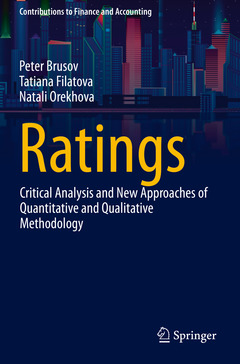Ratings, 1st ed. 2021 Critical Analysis and New Approaches of Quantitative and Qualitative Methodology Contributions to Finance and Accounting Series
Auteurs : Brusov Peter, Filatova Tatiana, Orekhova Natali

This book presents new methodologies for rating non-financial issuers and project ratings based on the BFO (Brusov-Filatova-Orekhova) theory of capital cost and structure, and its perpetuity limit (Modigliani-Miller theory), as well as modern investment models created by the authors.
It first provides a critical analysis of the methodological and systemic shortcomings of the current credit ratings of non-financial issuers and project ratings. In order to increase the objectivity and accuracy of rating assessments, it then modifies the BFO theory for companies of arbitrary age as well as and the perpetuity limit (Modigliani-Miller theory) for rating needs. The authors also incorporate the financial indicators used in the rating methodology into both the BFO theory and the Modigliani-Miller theory. Within the framework of the modified BFO theory for rating needs, they then present a detailed study of the dependence of the weighted average cost of capital of WACC, used as the discount rate for discounting financial flows, on the financial ratios used in the rating, on the age of the company, on the leverage level and on the level of taxation for a wide range of values of equity cost and debt cost for companies of arbitrary age. This makes it possible to correctly assess of the discount rate, taking into account the values of financial ratios.
The use of well-established corporate finance theories (BFO theory and its perpetuity limit) opens up new horizons in the rating industry, providing an opportunity to switch from mainly qualitative methods for determining the creditworthiness of issuers to mainly quantitative methods in rating, and as such improving the quality and accuracy of rating scores.
Introduction.- The Importance of Rating and the Disadvantages of Existing Rating Systems.- Part I Corporate Finance Theories used in Ratings and in Rating Methodologies.- Modern Theory of Capital Cost and Capital Structure: Brusov–Filatova–Orekhova Theory (BFO Theory).- Modification of the Modigliani–Miller theory for the case of advance tax on profit payments.- Modern Theory of Capital Cost and Capital Structure: Brusov–Filatova–Orekhova Theory (BFO Theory).- Part II Ratings and Rating Methodologies of Non–financial Issuers.- Application of the Modigliani–Miller Theory in Rating Methodology.- Application of the Modigliani–Miller Theory, Modified For the Case of Advance Payments of Tax on Profit, in Rating Methodologies.- Application of Brusov–Filatova–Orekhova theory (BFO theory) in Rating Methodology.- Part III Project Ratings.- Investment Models with Debt Repayment at the End of the Project and Their Application.- Investment Models with Uniform Debt Repayment and Their Application.- A New Approach to Ratings of the Long–Term Projects.- Ratings of the Investment Projects of Arbitrary Durations: New Methodology.- Ratings of Investment Projects of Arbitrary Duration with a Uniform Debt Repayment: a new approach.- Part IV New Meaningful Effects in Modern Capital Structure Theory (BFO Theory) Which Should be Accounting in Rating Methodologies.- The Golden Age of the Company (Three Colors of Company’s Time).- A "silver age" of the Companies. Conditions of existence of "golden age" and "silver age"effects`.- Inflation in Brusov–Filatova–Orekhova Theory and in Its Perpetuity Limit–Modigliani–Miller Theory.- A Qualitatively New Effect in Corporate Finance: Abnormal Dependence of Equity Cost of Company on Leverage Level.- The Impact of Taxing and Leverage in Evaluation of Capital Cost, Capitalization of the Company and Issued Ratings.- Recommendations to international rating agencies (Big Three (Standard & Poor’s, Fitch and Moody's), European) and national ones (ACRA, Chinese etc.).- Conclusions.
Petr Nickitovich Brusov is professor at the Financial University under the Government of the Russian Federation (Moscow)He has been a visiting Professor of Northwestern University (USA), Cornell University (USA) and Osaka City University (Japan) among other places. He is the author of over 500 research publications including six monographs, numerous textbooks and articles.
Tatiana Filatova is professor at the Financial University under the Government of the Russian Federation (Moscow). In the past 20 years, she has been dean of the faculties of financial management, management, state and municipal government at the Financial University. Tatiana Filatova is the author of over 250 research publications including five monographs, numerous textbooks and articles.
Natali Orekhova is professor of the Center of Corporate Finance, Investment, Taxation and Rating at the Southern Federal University, Rostov-on-Don, Russia. She has been a leading scientist of the Financial University under the Government of the Russian Federation. She is the author of over 100 research publications including three monographs, numerous textbooks and articles.
Provides an overview of recent developments in ratings methodology
Analyses the methodological and systemic shortcomings of the current credit ratings of non-financial issuers
Describes the advantages and shortcomings of both quantitative and qualitative methods for determining the creditworthiness of issuers
Date de parution : 12-2021
Ouvrage de 369 p.
15.5x23.5 cm
Disponible chez l'éditeur (délai d'approvisionnement : 15 jours).
Prix indicatif 89,66 €
Ajouter au panierDate de parution : 12-2020
Ouvrage de 369 p.
15.5x23.5 cm
Disponible chez l'éditeur (délai d'approvisionnement : 15 jours).
Prix indicatif 105,49 €
Ajouter au panierThème de Ratings :
Mots-clés :
Ratings; Methodology; Quantitative; Qualitative; Capital Markets



